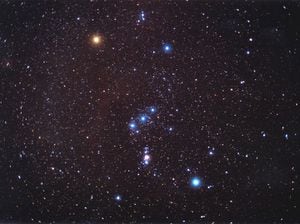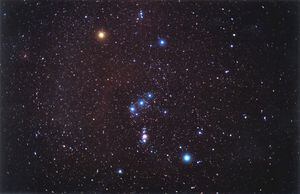Shropshire Sky At Night – January
Astronomy will never be the same again following the successful launch of the Webb Space Telescope on Christmas Day.

Late maybe, but full of potential, we can only anticipate what might be discovered.
Constellation of the month is Orion, a rare, but impressive, star group that looks like its namesake, the giant, club brandishing hunter, with a sword dangling from his belt. The seven main stars are among the top 70 brightest stars in the sky. They are not associated with each other but just happen to line up behind one another.
We must travel about 1,300 light years to reach the stars in Orion’s glistening belt together with the great Orion Nebular, which is our closest star factory containing hundreds of developing stars.

This month's must-see object(s) can be found at the ’kink’ in the tail of Ursa Major, the Great Bear. At a distance of 82 light years from Earth, you should be able to spot Mizar and Alcor, the most famous pair of stars in the sky, with the naked eye. Generations of astronomers referred to them as the ‘horse and rider.’ Together with a small telescope you should be able to identify Mizar has an orbiting companion, but you will need greater magnification to spot Alcor’s companion.
Closer to home Mercury can easily (with care) be spotted after sunset for a week either side of greatest elongation (its greatest distance from the Sun) which occurs on January 7.
After a fleeting appearance in the evening sky Venus returns to being a blazing ‘morning star’ by the end of the month. Mars proves difficult to spot as it’s so close to the horizon but Jupiter remains a brilliant object until it heads for the horizon late in the month.
Saturn, the ‘ringed wonder,’ lies 20 degrees west of Jupiter and can be seen if you have a flat south-western horizon soon after sunset during the first half of the month. To identify the ‘ice giants’ you will need binoculars or a small telescope, together with a good star map, but they are worthwhile targets throughout the month.
Pre-dawn (5.15am) on the 26th the extravagantly named Zubenelgenubi, shining brightly, is occulted by the Moon, in one of the years brightest occultation events.
An occultation is the event of the Moon obscuring our view of another planet or star. Observers are fascinated by the sight of the Moon steadily approaching its quarry before consuming it entirely only to reappear about an hour later at the opposite limb. Rising early and equipped with a pair of binoculars is all you need to observe this remarkable phenomenon.
Steve Szwajkun FRAS, Shropshire Astronomical Society





